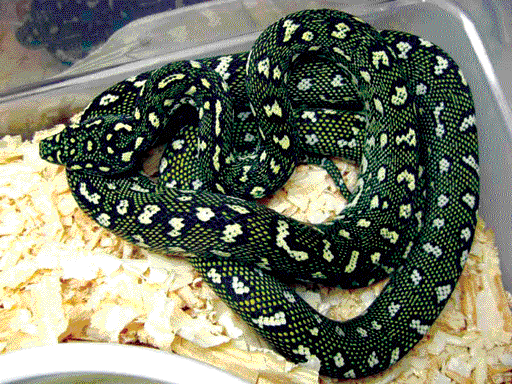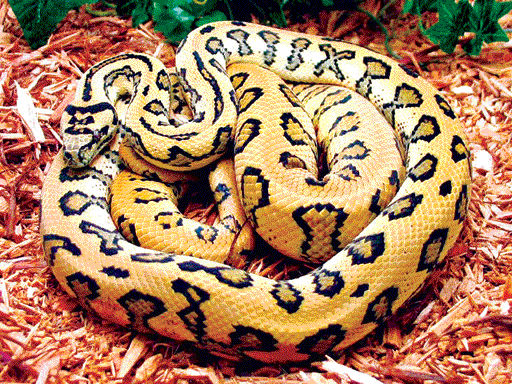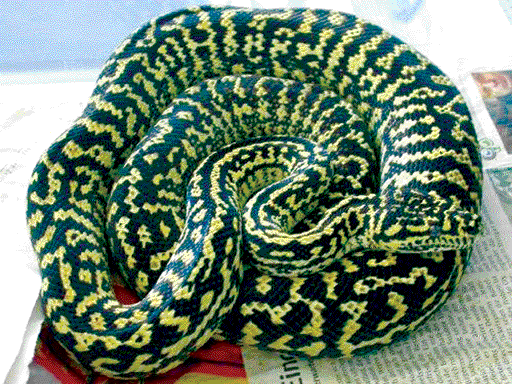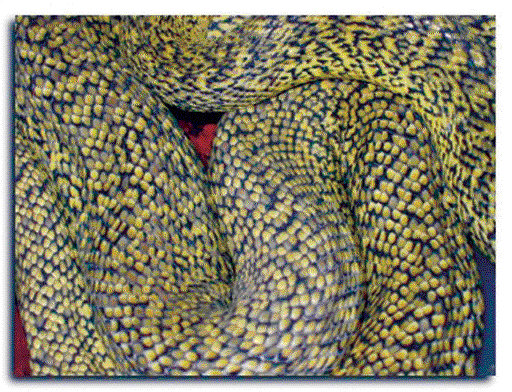Pythons, strikingly beautiful!
After
the long journey you made with us into the wild and beautiful world of
felines, we decided to take you down a different path of the animal
kingdom; the world of creepy-crawlies. Yes we are referring to the
cold-blooded, slippery, slithery creatures - the snakes.
Did anyone shriek just by reading the name and drop the paper like a
‘hot potato’? Well, we certainly hope not, because the creatures we
feature are not the venomous kind.
Anyway, it’s a fact that many are scared or feel squeamish about
snakes, venomous or not. But, at the same time, there are those who are
simply fascinated by them and even keep some non-venomous species as
pets.
No matter how people feel, snakes are an important part of nature and
they are here to stay. In a tropical country such as ours, there is an
abundance of snakes, but the species we feature today are not found
here.
As you may be aware, there are many species of snakes that slither
about in various parts of the world. In fact, it wouldn’t be wrong to
say that snakes come in all shapes, sizes, colours and designs too,
going by the variety of markings on their skins, especially since snake
breeders have begun to introduce new varieties through gene mutations
(alterations).
Pythons are not uncommon to us, but have you heard of pythons called
carpet pythons, tiger carpet pythons, jaguar carpet pythons and zebra
carpet pythons? Perhaps not.
These pythons with name tags of other animals are all subspecies and
morphs (colour and pattern mutations) of a species of pythons known as
the diamond pythons (Morelia spilota).
So, let’s check out the diamond species which has led to the ‘birth’
of some interesting varieties of pythons with rather unusual names and
attractive designs and colours on their skins! Some of these designs are
so striking that they are ideal as designs for fabrics.
Diamond pythons
 A
non-venomous species of pythons found in Indonesia, New Guinea and
Australia, the diamond python is the most wide ranging python in the
world. There are six recognised species; carpet python, jungle carpet,
coastal carpet, inland carpet, southwestern carpet and of course the
diamond carpet. A
non-venomous species of pythons found in Indonesia, New Guinea and
Australia, the diamond python is the most wide ranging python in the
world. There are six recognised species; carpet python, jungle carpet,
coastal carpet, inland carpet, southwestern carpet and of course the
diamond carpet.
The diamond carpet is the earliest known carpet python. It was first
described by a French naturalist named Lacapede way back in 1804
following specimens found in early settlements around the Sydney Harbour
in Australia.
Diamond pythons are considered striking in appearance and is named
after the intricate diamond shaped design on its skin. Typically the
diamonds have a black based skin with cream or yellow markings, but the
colours vary. The base colours could range from grey to variants of
brown with yellowish-gold markings. The heads are triangular shaped.
The males are smaller than the females. On average, the adults reach
a length of about four metres and weigh over five kilograms. The largest
of the species of diamonds is Morelia spilota (M.S.) macdoweli - that is
the nominate diamond python we are describing here. The smallest is M.
S. variegata (Carpet python) averaging lengths of 120-180 cm (4-6 feet).
These diamond pythons are semi-arboreal (relating to trees) and so
they climb trees, shrubs and rock faces. Even though these pythons are
nocturnal and activity is high in the nights, they could be found
basking (lying in warmth and sunshine) during daytime. Diamond pythons
can tolerate lower temperatures than other pythons.
It is found in a variety of habitats such as the rainforests of
northern Queensland, but they are not as common as they were once in
Sydney.
Like all pythons, the diamonds too survive on small mammals including
bats, birds and lizards. They are constricters (snakes that kill by
compressing). They strike and coil themselves around their prey until it
dies.
Diamonds are oviparous (egg laying) creatures and the females lay
eggs in clutches of 5-15 eggs at a time. Did you know that pythons
generally protect their eggs even though other snakes don’t? Well, the
diamond python mums too are very protective of their eggs so they
usually coil around the clutch of eggs and keep them safe until they
hatch.
During this incubation period, the mother loses about 30 per cent of
her body weight. The protection ceases the moment the eggs are hatched
and the baby pythons are then left to fend for themselves!
Diamond pythons are popular as pets. They can be fed with mice and
rats in captivity. The average lifespan of these pythons is between 15
to 20 years.
Carpet pythons
A diverse subspecies of the strikingly patterned diamond python, the
carpet python is so named because the markings on some specimens
resemble the patterns of old fashioned carpets.
The colour patterns vary greatly; pale to dark brown and olive green
to grey or reddish with darker blotches. Their heads are rather large
and their bodies slender, but robust (strong and sturdy).
Found mostly in Australia and New Guinea, the carpet pythons live in
different habitats such as grasslands and wooded savannahs. Of the many
carpets, the jungle carpet (M.S. cheynei) is the most brightly coloured
and the smallest (as we mentioned earlier).
All carpet pythons are highly arboreal and nocturnal. However, they
will bask during the daytime when necessary. They stalk, capture and
subdue their prey which include mice, rats, birds, possums and
marsupials.
Feeding in captivity is not a problem. They are kept as pets.
Jungle carpet pythons
With heads like those of dragons and bodies which are not very thick,
these medium-sized pythons grow to a length of 5.7 feet to 6 feet. Even
though they are not fully arboreal like the tree boas, their prehensile
(capable of grasping) tails help them in their arboreal pursuits.
The brightest jungle carpet is jet black with bright yellow markings
and a pure white underside. The average colours are yellow-tan blotches
and pine white undersides. With each shedding of skin, the colours
become lighter.
The adult colour of the skin is evident by the time the pythons are
2-3 years old. Jungle carpets are well-known for their dark black and
rich golden-yellow colouration.
They have been crossed with diamond carpet pythons and coastal carpet
pythons for more then 30 years to breed new varieties which are becoming
very popular, especially for their colouration and markings. Coastal
carpets are large, reaching a length of about 14 feet and one known to
be aggressive. They are also hardy snakes in captivity, so most breeders
cross them with other carpets.
Tiger carpet pythons
 Introduced
around the mid 1990s, these morphs of carpet pythons vary from other
striped or tri-striped carpet pythons. Believed to have originated in
the United States, the earliest photograph of a tiger carpet was
displayed around 1980. Introduced
around the mid 1990s, these morphs of carpet pythons vary from other
striped or tri-striped carpet pythons. Believed to have originated in
the United States, the earliest photograph of a tiger carpet was
displayed around 1980.
What sets this particular morph apart from other striped or
tri-striped carpets is its wider dorsal (of or on the back) stripes.
Typically, (these pythons which are a result of co-dominant mutations),
turn out into gorgeous cream-white to yellow colours at maturity.
Even though morphs of carpet pythons were not very popular at one
time,(especially since the export of carpet pythons which are native to
Australia are prohibited), now they are gaining attention. More and more
morphs are being introduced following the advent of the jaguar carpet
python, which is considered a beauty!
Jaguar carpet pythons
 They
are a spectacular species (a morph) of the carpet pythons. In fact they
are responsible for the rising popularity of the carpet python. Jaguar
morphs are getting better every year with their marking improving
greatly. Generally, all carpet pythons undergo dramatic colour changes
as they mature. But Jaguars are known to undergo even more drastic
colour changes as they reach maturity. They
are a spectacular species (a morph) of the carpet pythons. In fact they
are responsible for the rising popularity of the carpet python. Jaguar
morphs are getting better every year with their marking improving
greatly. Generally, all carpet pythons undergo dramatic colour changes
as they mature. But Jaguars are known to undergo even more drastic
colour changes as they reach maturity.
Recently there has been an explosion of snake mutations, both
naturally occurring and created in captivity by breeders. So a variety
of new morphs and hybrids are being introduced, especially for the
exotic pet market. They are readily available as domestically bred stock
and many like to have them as pets because they are easy to care for.
There are even designer breeding centres where strikingly beautiful
pythons are bred.
Some morphs developed and being developed of carpet
mutations
Tri-stripe coastal pythons
Caramal coastal
Tiger coastal
|

Zebra jungle |
Jaguar coastal (relatively new morph)
Zebra jungles
Granite Irian Jayas
Mortley Irian Jayas
Diamond Jungle Jaguar pythons
Pythons
There are more than 27 species of pythons found in Asia, Australia,
Africa and Central America (one species). Many extend lengths of over
25feet (7.5m) and weigh up to 300lbs!
|

Irian jaya |
|

Irian jaya |
They
are a subfamily of a group known as the Boid’s (boidae) which include
boas. All five of the giant snakes along with some other smaller species
of snakes belong to this family. The pythons are known as the giants
among the entire genus of snakes but the boa (anaconda) is classed as
the largest snake in the world. The name python comes from a giant
serpent in Greek mythology.
Fact file
* Typically, carpets live to 20-30 years in captivity
* The first genetic morph of the python, jungle carpet is the zebra
carpet python which is strikingly beautiful with its intricate markings.
* Tiger carpet pythons are another morph of coastal carpets with bold
dorsal striped patterns, and striped or broken striped patterns on the
sides, covering the length of its body. |
